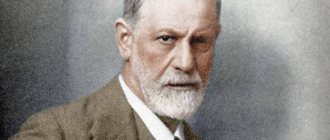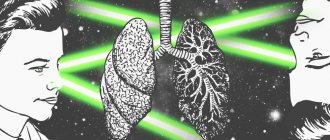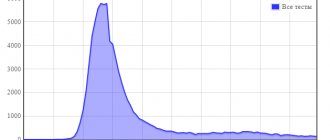- Characteristics of short-term memory
- What is long-term memory?
- The relationship between short-term and long-term memory
Your own internal memory is the most important mental process. Throughout life, the human brain perceives, processes, stores and reproduces various information, some of which is stored in memories for a short time, while another part can be reproduced even after several years. What are these features of the memorization process associated with? This is primarily due to the fact that a person has 2 completely different types of memory:
- long-term;
- short-term.
It is these types that determine what information will be stored in the cerebral cortex for just a few minutes, and what information will be “imprinted” there for many years.
In psychology, there is an opinion that the process of memorization and assimilation, as well as the volumes that short-term and long-term memory can hold, is largely influenced by genetic predisposition.
What 5 types of memory improve short-term memory?
Let’s make a reservation that by short-term we will take the memorization of information for minutes, hours, days.
Every day a person is faced with large amounts of information. To process it and use it correctly, you need a good memory. In mental activity, the process of communication, reading and many other areas, a short-term version of it is used. It helps to process various information.
But some people notice that it is difficult for them to make a decision, answer a question based on an overheard conversation, remember a phone number or the name of a salesperson seen on a badge in a store. In this case, you need to work on yourself and improve your memorization abilities.
Determine the type of short-term memory for “refinement”
Depending on the source of information and the individual characteristics of the brain, there are several types of it:
- visual;
- tactile;
- taste;
- olfactory;
- auditory
Before improving memorization and short memory, you need to find out which type works worse and which is more developed. Most people use visual and auditory systems most often. But for some people, to remember better, they need to write down information so that muscle memory works.
Some people use the association method to remember: they associate what they need to remember with some smell or taste.
Features of auditory memory
Many people find it much easier to remember information by hearing than by making eye contact. So, when learning a poem, some children need their parents to first read it to them several times. Auditory memory is a person’s ability to remember and assimilate, store and subsequently reproduce sound information.
Every person has auditory memory to one degree or another. Someone can easily reproduce verbatim the information they have heard briefly. For some people this is more difficult. But even if, after carefully listening to the lecture, you did not remember anything from it, you should not think that this type of memory is completely unusual for you. Perhaps your brain simply does not want to perceive information that is not interesting to you, because in a conversation with a friend, almost everyone will remember what exactly he told you about.
What is short-term memory
There are usually three types of memory: sensory, short-term and long-term. Sensory memory is the first memory to enter the human brain. It lasts a fraction of a second - long enough for us to feel something: the touch of clothing on the skin, the smell of smoke, the sound of wind, the sound of thunder and the flash of lightning. We use this memory in the future, but now, immediately after manifestation, it disappears.
Just now, you didn’t notice the touch of the watch bracelet on your hand, but now this feeling has surfaced in your memory, because I reminded you of it and transferred your sensory memory to the short-term area.
Short-term memory contains current events - what you are thinking about at the moment. You use it constantly without realizing it. For example, you understand the end of a sentence only because you remember the beginning. It is believed that short-term memory can hold about seven objects for 15–30 seconds.
But if you repeat these seven objects, they will move into long-term memory - a potentially limitless store of memories,
It helps to process information that comes from various external stimuli. It is stored in the brain for varying periods of time, but usually no longer than 3 months. Short memory is used in learning, when reading, helps answer questions, focus on a problem and perform several tasks at the same time.
The better it is, the higher the intelligence indicators. Previously, it was believed that it could only be trained in childhood, by memorizing poems, etc. But there are many ways to improve memory for an adult.
First you need to understand that her work is related to the ability to concentrate, to concentrate. Therefore, you need to try to remove distractions at the moment when you need to remember something.
Studying to the sound of TV or music is ineffective.
Development of memory and thinking
Thinking is also one of the facets of human consciousness. Since our consciousness is integral, pumping up any of its manifestations will have a positive effect on training the entire consciousness and its other elements, including thinking. If you train memory and attention, then your thinking experiences positive transformations.
It’s like in sports: even if a person bench presses a barbell, his form will still be better than that of someone who does not play sports at all.
To develop thinking, you need to perform information visualization exercises, because these two aspects are inextricably linked. A person cannot understand information that he cannot visually represent. For example, if in the simplest arithmetic problem you replace objects with abstractions, then an adult will not always be able to understand what is being said.
How to deal with forgetfulness
6 simple recommendations
Often, deterioration in memory is associated with a decrease in the efficiency of the brain. "Brains don't cook." There are several recommendations on how to make your memory “longer” using typical, one might say folk, methods, and they are suitable for any adult:
- Avoid stress
- Reduce anxiety
- Don't worry about trifles
- To remember something easier, you need to calm down
- Reduce the information load during training. remove all distractions
- Need to increase physical activity
Scientific research has proven that intense physical training and strength exercises help improve memory. This is due to good blood flow in the brain when performing them. If you have been sitting on a chair for too long and need to work productively, you can:
- Raise your arms up, then raise your knee while touching it with the opposite hand. The arms should return to the starting position, the exercise is performed at a high tempo. It is not too tiring, the load is easy to adjust and highly effective.
- Get a good night's sleep.
Getting at least 8 hours of sleep at night improves the efficiency of your brain and memory. You can verify this by passing various tests BEFORE and AFTER a good sleep.
- You can improve your memory efficiency by eating right.
To do this, increase the proportion of antioxidants, B vitamins, beta-carotene, Omega 3 fatty acids. It is useful to eat walnuts, fatty fish, eggs, cocoa, blueberries, and broccoli.
- You need to give up bad habits, as alcohol and nicotine impair memory.
- Collect puzzles, solve crosswords, puzzles more often. This will help activate the lobes of the brain that are not involved in everyday work and keep them in good shape.
- Training on simulators for memorizing different types
Effective exercises for developing different types of memory
- look at a stranger for a couple of seconds, then close your eyes and try to remember what he is wearing, what signs he has; This exercise can be done in any environment - in transport, while walking.
- put 10 different objects on the table, look at them for a minute, then cover them with a cloth and try to describe them in detail. You can start with two items. Remember the movie “The Mystery of Two Oceans”, when on a submarine, after such training, the boy noticed the absence of an alarm clock on his teacher’s desk. It turned out it was a time mine, and the teacher was a spy and saboteur. Mina, of course, was found at the last moment, and so was the spy.
- ask someone to read 10 words or a paragraph from the text, and then repeat what they remember. This can also be done alone. Take a passage of text and play it back using a voiceover program.
Neurophysiology
In 2011, an important discovery was made at Duke University (a private research institution in the USA, North Carolina) at the medical center. Scientists have described in detail the neural circuit that is the basis of long-term memory. The signal lasts only 10 minutes, but strong connections are formed that do not disintegrate for a sufficiently long period and can persist throughout life.
Before this, neuroscientists could not figure out how such strong and long-lasting contact was established between the links of this chain. It turned out that long-term memory is based on pure biochemistry: the connection between them is determined by signaling proteins, which, in turn, provide a stable neuronal cellular framework of actin. This is a globular protein, thanks to which the links do not sag or break.
This phenomenon was called long-term potentiation. Its approximate scheme includes two stages.
Stage 1. Primary
A short nerve electrical impulse (new, previously unknown to the central nervous system) → Establishment of contacts between neurons → Formation of a strong actin cytoskeleton (electrical column along which the impulse travels) → Response (saving the necessary information).
From a biochemical point of view, the launch of a signal and the establishment of contacts between neurons looks like this:
A powerful flow of calcium ions into the synapse → Launch of a kinase called CaMKII (an enzyme that controls the activity of signaling proteins using phosphates) → Activation of two proteins, Rho and Cdc42 → Formation of the actin cytoskeleton.
Stage 2. Secondary
The same short nerve electrical impulse (already known to the central nervous system) → Its conduction along the same actin cytoskeleton along which it has already passed → Response (reproduction of the necessary information).
The second chain is much faster in speed than the first, because contacts between neurons have already been established earlier, just as the actin cytoskeleton is also formed. The more often a person remembers some event from the past (triggers that same impulse), the faster he reproduces it, no matter how long ago it happened, because the central nervous system already knows the path along which this signal is sent.
The biochemical basis of long-term memory has become available to Duke University scientists thanks to a special laboratory microscopy method. It allows you to see molecular transformations in the synapse during the formation of a strong neuronal cytoskeleton.
The discovery of American scientists led to the conclusion that long-term memory is based on complex biochemical processes. In addition, it was revealed that Alzheimer's disease, dementia, and many neurological pathologies associated with the inability to restore memories from the past are accompanied by damage to two proteins Rho and Cdc42, which are responsible for the formation of the actin cytoskeleton.
Before this discovery, there were two completely different theories of LTP: glial (the activity of neuroglia) and the immunochemical mechanism (synthesis of antigens on synaptic membranes and antibodies to them in glial cells).
Methods to improve memory
Concentration
For information to be remembered, you need to concentrate your attention on it. Often people forget names, phone numbers, faces only because they do not attach importance to it. “It went in one ear and out the other.” The best method to solve the issue is to wake up. It has already been said that many people “dream awake” and act on autopilot. You need to REMEMBER the need to concentrate on an object in order to remember new information.
Object grouping method
Used by most people to remember information. You need to divide it into groups of 2-3 objects. With such volumes it is remembered faster. The method is often used when memorizing long telephone numbers.
Emotions
It has been proven that information accompanied by an emotional outburst is remembered better. Therefore, it is recommended to come up with a story, perhaps a ridiculous one, with which the consequences of forgetting will be associated. For example, to remember that you need to go get a haircut, you can think: “If I don’t get a haircut, I’ll get lice,” and then vividly imagine this process.
Target
Remember yourself at school - “why should I learn this? I will never… blah blah blah…” To better concentrate on what you need to learn, it is recommended to set yourself a specific goal. Without this, the brain will not be able to remember.
Associations
Information must be accompanied by simple and understandable associations. Then less time and effort will be spent on memorizing it. For example, learn a phone number to the accompaniment of your favorite melody. Sing it to music.
Repeat
The repetition method is also effective. Here long-term memory will work more. To remember better, you need to repeat the information several times.
Maintain a healthy sleep pattern
The only time our minds rest is when we sleep. Well, it would be technically incorrect to say that the mind is at rest when we sleep. Even then, the brain carries out different processes, such as breathing. But when we sleep, this is the only state when our brain cannot actively absorb and process information.
Research has shown that adequate sleep improves various brain functions. The same is true for our memory. A tired brain is terrible at storing and processing information. This is why if you want to improve your short-term memory, then you must have a healthy sleep pattern.
Effective exercises
There are many exercises to improve your memory. They are most often used for children, but also work effectively on adults. But it’s not enough to just know how to improve short-term memory with exercises. You need to exercise regularly, at least 20-30 minutes every day. For the training to take effect forever, 1.5-2 months must pass. Scientists (and you yourself feel it) have already proven that memory needs to be improved; without constant training it gradually deteriorates. To do this, you can use the most popular exercises. It is recommended to perform each of them 5-6 times daily.
- "Fibonacci Technique". It involves mentally naming a certain series of numbers. Each subsequent one is the sum of the previous ones.
- "20 words." You need someone to write 20 unrelated words on a piece of paper. You need to look at them for a minute, you can pronounce them. After that, remember. It is important not only the number of words remembered, but also their order.
- "Paragraph". Open any book at random and read the first paragraph you come across. After this, you need to retell it as close to the text as possible.
- "Pythagorean Technique". In the evening, you need to remember all the events of the day, starting from waking up. Try to reproduce them in detail and in the correct sequence.
- "Making up words." This exercise effectively activates the brain. You need to come up with 10 words for each letter of the alphabet.
You don’t have to set aside separate time for memory training exercises, but do them throughout the day. Pay attention to posters, remember 10 products on a store window, remember a song you heard in the morning. Each has its own effective methods. You can use only one exercise or use all methods. But short-term memory can and should be trained.
Meditate
Important aspects of meditation are learning to control your thoughts and being aware of your surroundings. It also helps clear your brain of negative or unimportant thoughts. So, practicing meditation will help you filter what is important and what is not. Once you have weeded out all the unnecessary information from your brain, important information becomes easy to store.
Meditation is often depicted as an upright posture with folded legs and outstretched arms. However, meditation is not just about posture; it is a technique that can be used anywhere and anytime.
The best way to start practicing meditation is to meditate for a few minutes every day in bed, both before going to bed and when you wake up in the morning. [2]It is easy and simple to practice.
Violations
Disorders include underdevelopment of long-term memory, when a person simply does not know how to correctly encode and reproduce information, and complete amnesia, which is characterized primarily by damage to the hippocampus. If in the first situation everything can be corrected through constant training, then in the second the forecasts most often remain unpredictable.
Causes
Physiological:
- asthenia;
- liver intoxication;
- damage to the central nervous system and brain: head injury, post-stroke condition;
- intellectual disorder, schizophrenia;
- chronic alcohol or drug intoxication.
Mental:
- overwork;
- neuroses;
- constant stress;
- excessive emotional and mental stress;
- depression;
- psychotrauma;
- dysthymia: constant bad mood.
Household:
- poor nutrition;
- lack of sleep;
- excessive physical and intellectual stress;
- improper planning of the day, lack of routine.
Symptoms
- Difficulties with conscious memorization: poems, dates, exam material learned by heart are poorly retained in memory and are reproduced with errors;
- inability to remember events from the distant or near past, memory lapses;
- confusion, violation of cause-and-effect relationships;
- forgetfulness in basic everyday situations: didn’t make a report, didn’t come to a meeting, didn’t buy bread for home;
- social maladjustment;
- decreased mental capacity and performance;
- inattention, inability to focus and concentrate;
- confusion.
If violations of short-term memory lead primarily to everyday problems (when you don’t remember what you did 5 minutes ago), then the consequences of damage to long-term memory affect almost all areas of life. At work, this leads to poor performance of one’s duties, and in the family – to the breakdown of personal relationships. The person turns out to be socially maladapted. Even if his DVP is simply poorly developed, he will not be successful compared to other students (students, employees), not to mention various forms of amnesia.
For more information about what causes memory impairments, how they manifest themselves and how to get rid of them, read our separate article.
Characteristics
The main characteristics of long-term memory are best considered against the background of its comparison with short-term memory.
Separately, it is worth paying attention to the fact that the volume of human long-term memory is supposedly 1 million GB of information. Until recently, scientists could not give an exact figure and hypothesized that it was impossible to determine the limit of this characteristic. However, in the age of computerization, the brain is often compared to processors. Research in this area has suggested that fiberboard storage is similar to a hard drive, which can hold that same 1 million GB. The figure is approximate and still requires scientific justification.











